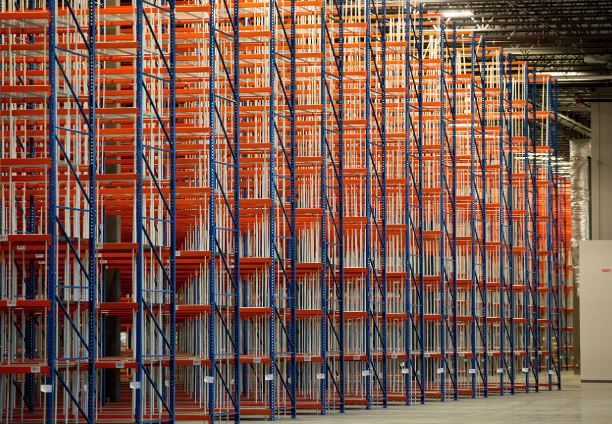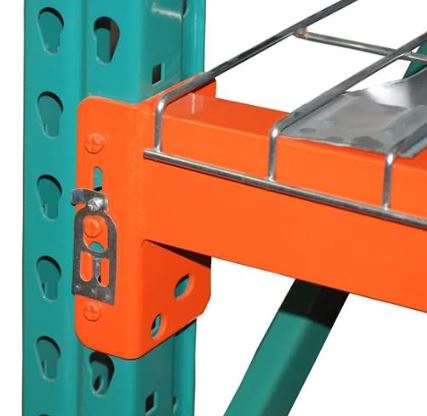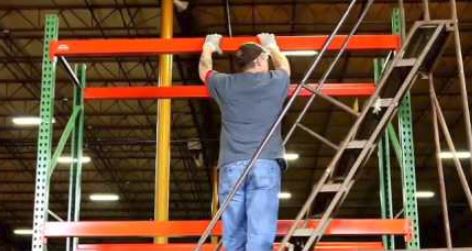Pallet racking breaks down into two main forms: roll formed racking and structural racking. The latter is used for heavy duty applications that involve a high level of throughput and large amounts of weight. If you are in a high volume, fast-moving environment with a lot of forklifts running at one time, structural racking systems are the way to go, as impacts with the racking system will occur over time.
Roll formed rack is the other option. In the last several years, the racking industry has started to  standardize roll formed racking to the teardrop design. Teardrop racking is the most prevalent option currently being sold, as it’s a bit more cost effective and strong enough for most racking needs. It’s not always necessary to go with the biggest and strongest racking system, which is where structural racking comes into play.
standardize roll formed racking to the teardrop design. Teardrop racking is the most prevalent option currently being sold, as it’s a bit more cost effective and strong enough for most racking needs. It’s not always necessary to go with the biggest and strongest racking system, which is where structural racking comes into play.
Teardrop Racking Advantages
As a quick refresher, teardrop racking systems are easier to modify and install than the structural options. The teardrop name comes from the shape of the punch hole in the upright where the cross beams fit, and you can add and remove beams as needed.
With teardrop racking systems, you also have easier adjustability with a spring-hinge pin concept, allowing you to adjust beams on  the fly, as opposed to the structural systems, which are typically nut and bolt requiring tools to adjust. Another main benefit of a teardrop system is the customization and universal compatibility among manufacturers. However, that comes with one major caveat which I’ll get to shortly.
the fly, as opposed to the structural systems, which are typically nut and bolt requiring tools to adjust. Another main benefit of a teardrop system is the customization and universal compatibility among manufacturers. However, that comes with one major caveat which I’ll get to shortly.
The main reason teardrop systems are so popular is due largely to the cost. Let’s face it, if the stronger and more robust racking system was the least expensive, most everyone would be buying it. Yes, there are other great aspects to these racking systems, but the cost when compared to a more heavy-duty structural system can often be 20%-40% less expensive.
Measure Your Beams Before Buying
If you’ve ever bought a flat screen television, you may have noticed the fine print of  the screen size in the manual or on the box. The 65-inch television might not be quite 65 inches, but rather 64.5 inches. This is called a “nominal” measurement. While the difference between 65 and 64.5 inches for a television isn’t a big deal, that’s not the case for pallet racking.
the screen size in the manual or on the box. The 65-inch television might not be quite 65 inches, but rather 64.5 inches. This is called a “nominal” measurement. While the difference between 65 and 64.5 inches for a television isn’t a big deal, that’s not the case for pallet racking.
Many manufacturers measure their beams slightly differently. One 96-inch beam might be 95.75 inches. The other might be 96.25 inches. This means most likely you cannot use beams from different manufacturers in the same bay as they won’t measure the exact same length. This is steel. You can’t fudge half of an inch.
What to Know Before You Install
Installation for teardrop racking systems is straightforward and turnkey, however there is one major aspect to be aware of, and that’s local permitting requirements. Depending on the job, you may need stamped drawings and seismic calculations. Often, the penalty for installing racking without permits can lead to hefty fines.
The good news is Abel Womack can help those interested in teardrop racking systems — and structural, if you need a more heavy-duty solution. From assessing your storage needs through installation, our rack experts will walk you through the options available and help determine your needs and the most effective use of your budget. Contact our professionals today for all of your material handling needs.



Leave a Reply
You must be logged in to post a comment.